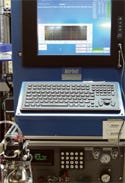Retooled testing techniques enabled better quality control of an oxygen-delivery device
March 9, 2008
Originally Published MPMN March 2008
ENGINEERING SOLUTIONS
Revised Calibration and Test Methods Improve Production Throughput
Retooled testing techniques enabled better quality control of an oxygen-delivery device
|
InterTech's functional test instrument controls vacuum during testing without the use of valves. |
Unlike continuous-flow oxygen-delivery systems, the Spirit portable oxygen conservation device (OCD) minimizes oxygen use because it only flows when triggered by inspiration in a natural breathing cycle. Manufactured by Caire Inc. (Cleveland; www.cairemedical.com), a division of Chart Industries, the Spirit is calibrated so that when a patient takes a breath, the prescribed amount of oxygen is not only delivered, but done so in a way that is in sync with a patient’s natural breathing cycle. Quality control tests further guarantee that units will only trigger when the patient takes a breath, will perform adequately in low-battery conditions, and will accurately reflect such status in the indicator LED.
Launched in 2001, the original Spirit unit underwent calibrations that proved to be tedious and dragged on production throughput. “It was not an industrially robust system, required frequent calibration, and was even prone to the problems of PCs running Windows-based technology,” says Kevin Rogers, manufacturing engineer.
The firm turned to InterTech Development Co. (Skokie, IL; www.intertechdevelopment.com), whose focus on test technology had enabled it to increase yields in test-intensive production lines. After reviewing machine specifications and algorithms necessary to test and calibrate the system’s operations, InterTech suggested that a change was needed. “The previous test system was a mechanical device, a sort of bellows, to simulate the draw of breath,” says Dave Balke, senior product engineer at InterTech. “Our applications lab determined that this was problematic both in terms of response time and repeatability.”
An InterTech M-1035z functional test instrument that controls vacuum up to 0.300 H20 nominal without interfering with pulse flow helped overcome this obstacle. “This is very important when you are trying to closely simulate a breath triggering a flow pulse that you want to measure,” Balke says. “InterTech’s method controls the vacuum precisely without using any valves, and consequently bypasses the constant valve failures that had plagued the previous test system.”
The complete functional test of the system from 22 to 52 psig includes an autotriggering test to ensure that it does not operate unintentionally, a sensitivity test to detect the vacuum level at which the unit pulses, a pulse volume test at six positions to verify that the delivered volume is within specification of each setting, continuous flow tests by selecting the control flow, green and red LED tests, a battery test at low-voltage pulse settings that tests monitoring volumes between the 13 and 80 ml/pulse accept limits, and an optional apnea test.
Sensitivity calibration is achieved by monitoring the pressure at the Spirit’s cannula port as a breath is simulated, and adjusting the unit’s OCD sensitivity potentiometer to the desired value range. Manifold calibration monitors the pulse volume while the test station simulates breaths, and requires adjusting the OCD manifold’s flow-control valve.
“It used to take 3½ to 4 minutes to test each unit. Now we completely test in half that time,” Rogers says. “As an added bonus, the InterTech system is identifying 2.5% of production units with a defect that we couldn’t identify before. While these defects are small enough to never be noticeable to or compromise a patient, it does give us the ability to more closely control our processes and vendor quality.”
Copyright ©2008 Medical Product Manufacturing News
You May Also Like



